University of Western Sydney Epidemiology Assignment 2, SCCS2, 2019
VerifiedAdded on 2022/11/25
|8
|1552
|314
Homework Assignment
AI Summary
This assignment solution addresses key concepts in epidemiology, focusing on a case-control study investigating folic acid supplements and the risk of facial clefts. It analyzes study design, justifications, and the feasibility of a randomized controlled trial. The solution calculates and interprets odds ratios, assesses measurement bias, and provides a 2x2 table to determine the association between smoking and cleft lip. Furthermore, it delves into the association between diabetes and atrial fibrillation, stratified by sex, calculating attributable risk and identifying confounding factors. Finally, the solution explores potential biases in a study examining hormone use during pregnancy and childhood cancer, including reporting bias and confounding, and their impact on relative risk.

The University of Western Sydney
School of Science and Health
Introduction to Epidemiology (401076)
ASSIGNMENT 2
SCCS2, 2019
Due date: 11:30 PM, 08 September 2019
This assignment is based on the learning objectives and concepts in Topics 2-5 but
may also require knowledge from Topic 1. There are a total of 60 marks and this
assignment will contribute 30% towards the total assessment for this subject.
Your assignment should be typed, with adequate space left between questions.
Assignments should be submitted via vUWS (see specific instructions relating to
Assignment 2 on the 401076 vUWS web-site). Be as brief as possible in your answers
and use the number of marks for a question as a guide to how much to write. No
answers need to be longer than a few short sentences or short paragraphs. Please note
this is an individual exercise.
Late assignments will not be accepted without prior approval.
School of Science and Health
Introduction to Epidemiology (401076)
ASSIGNMENT 2
SCCS2, 2019
Due date: 11:30 PM, 08 September 2019
This assignment is based on the learning objectives and concepts in Topics 2-5 but
may also require knowledge from Topic 1. There are a total of 60 marks and this
assignment will contribute 30% towards the total assessment for this subject.
Your assignment should be typed, with adequate space left between questions.
Assignments should be submitted via vUWS (see specific instructions relating to
Assignment 2 on the 401076 vUWS web-site). Be as brief as possible in your answers
and use the number of marks for a question as a guide to how much to write. No
answers need to be longer than a few short sentences or short paragraphs. Please note
this is an individual exercise.
Late assignments will not be accepted without prior approval.
Paraphrase This Document
Need a fresh take? Get an instant paraphrase of this document with our AI Paraphraser
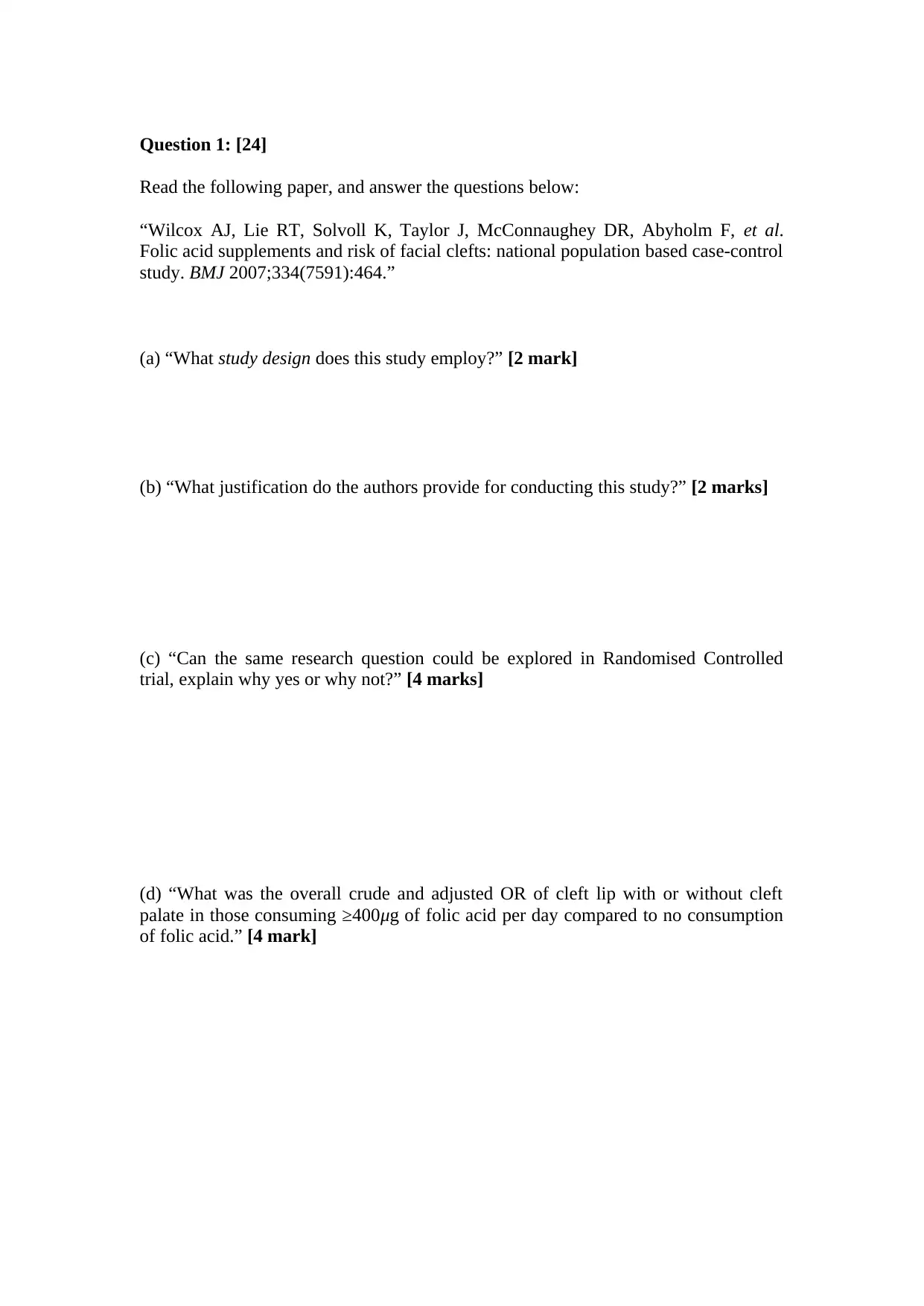
Question 1: [24]
Read the following paper, and answer the questions below:
“Wilcox AJ, Lie RT, Solvoll K, Taylor J, McConnaughey DR, Abyholm F, et al.
Folic acid supplements and risk of facial clefts: national population based case-control
study. BMJ 2007;334(7591):464.”
(a) “What study design does this study employ?” [2 mark]
(b) “What justification do the authors provide for conducting this study?” [2 marks]
(c) “Can the same research question could be explored in Randomised Controlled
trial, explain why yes or why not?” [4 marks]
(d) “What was the overall crude and adjusted OR of cleft lip with or without cleft
palate in those consuming ≥400μg of folic acid per day compared to no consumption
of folic acid.” [4 mark]
Read the following paper, and answer the questions below:
“Wilcox AJ, Lie RT, Solvoll K, Taylor J, McConnaughey DR, Abyholm F, et al.
Folic acid supplements and risk of facial clefts: national population based case-control
study. BMJ 2007;334(7591):464.”
(a) “What study design does this study employ?” [2 mark]
(b) “What justification do the authors provide for conducting this study?” [2 marks]
(c) “Can the same research question could be explored in Randomised Controlled
trial, explain why yes or why not?” [4 marks]
(d) “What was the overall crude and adjusted OR of cleft lip with or without cleft
palate in those consuming ≥400μg of folic acid per day compared to no consumption
of folic acid.” [4 mark]
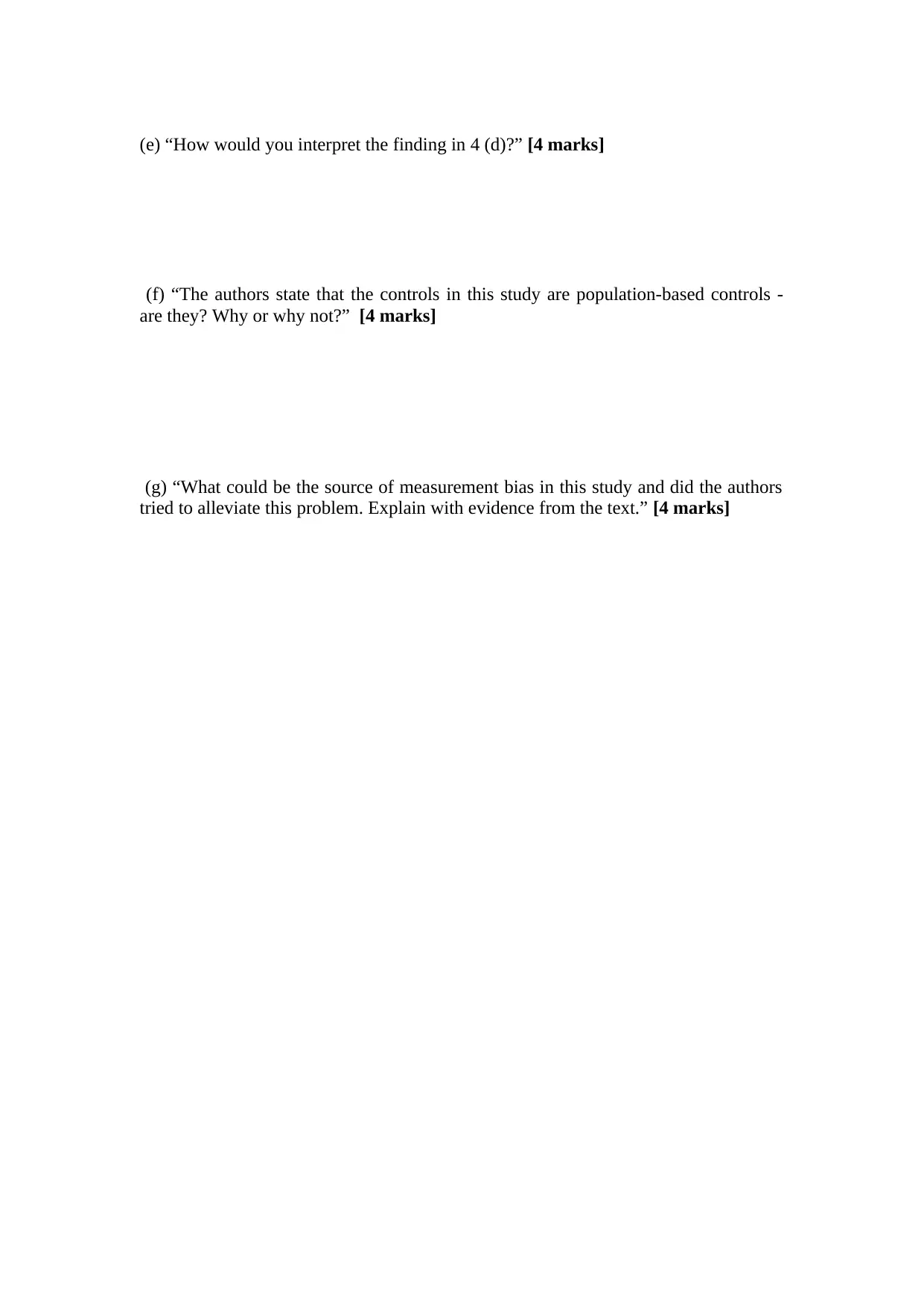
(e) “How would you interpret the finding in 4 (d)?” [4 marks]
(f) “The authors state that the controls in this study are population-based controls -
are they? Why or why not?” [4 marks]
(g) “What could be the source of measurement bias in this study and did the authors
tried to alleviate this problem. Explain with evidence from the text.” [4 marks]
(f) “The authors state that the controls in this study are population-based controls -
are they? Why or why not?” [4 marks]
(g) “What could be the source of measurement bias in this study and did the authors
tried to alleviate this problem. Explain with evidence from the text.” [4 marks]
⊘ This is a preview!⊘
Do you want full access?
Subscribe today to unlock all pages.

Trusted by 1+ million students worldwide
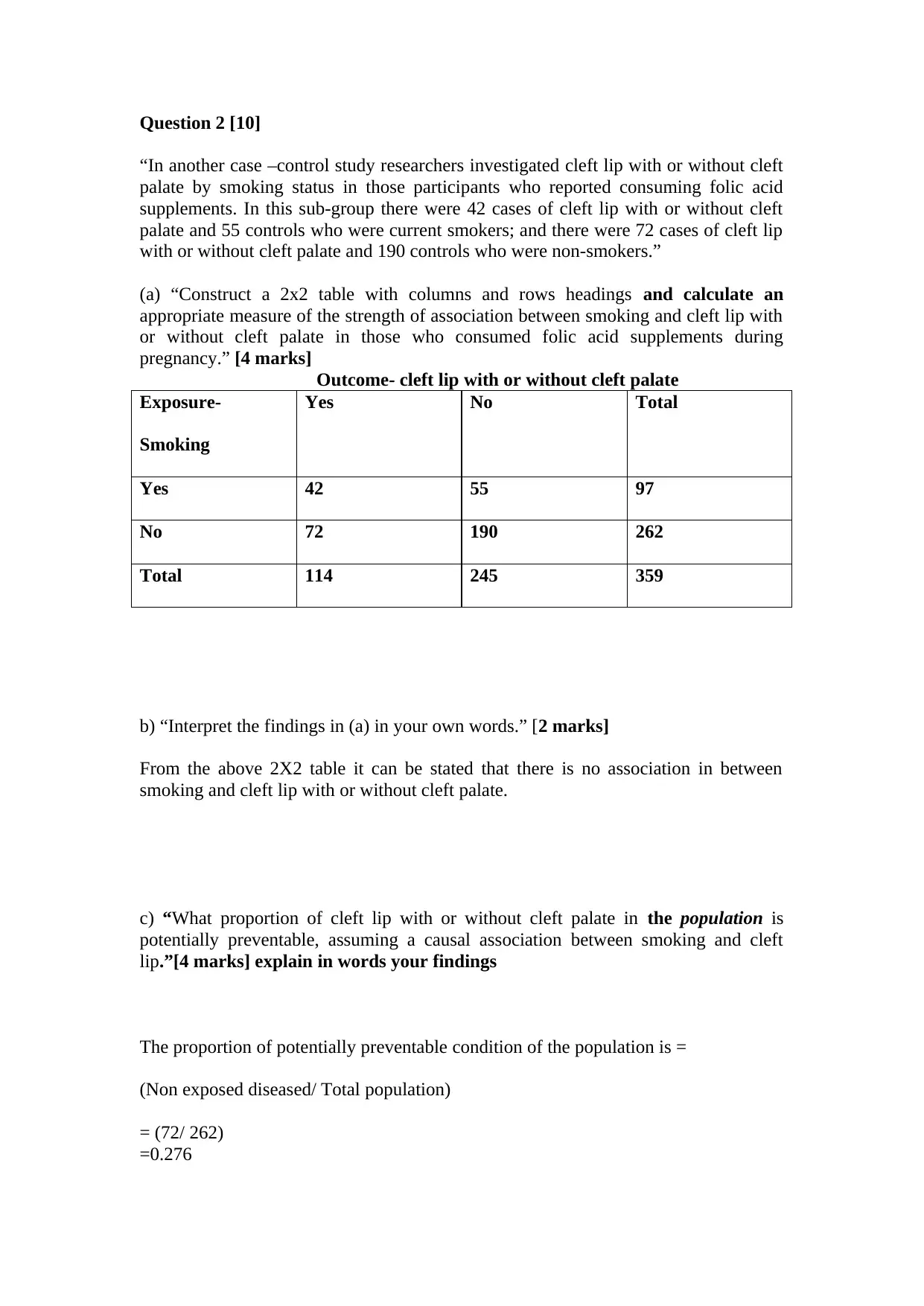
Question 2 [10]
“In another case –control study researchers investigated cleft lip with or without cleft
palate by smoking status in those participants who reported consuming folic acid
supplements. In this sub-group there were 42 cases of cleft lip with or without cleft
palate and 55 controls who were current smokers; and there were 72 cases of cleft lip
with or without cleft palate and 190 controls who were non-smokers.”
(a) “Construct a 2x2 table with columns and rows headings and calculate an
appropriate measure of the strength of association between smoking and cleft lip with
or without cleft palate in those who consumed folic acid supplements during
pregnancy.” [4 marks]
Outcome- cleft lip with or without cleft palate
Exposure-
Smoking
Yes No Total
Yes 42 55 97
No 72 190 262
Total 114 245 359
b) “Interpret the findings in (a) in your own words.” [2 marks]
From the above 2X2 table it can be stated that there is no association in between
smoking and cleft lip with or without cleft palate.
c) “What proportion of cleft lip with or without cleft palate in the population is
potentially preventable, assuming a causal association between smoking and cleft
lip.”[4 marks] explain in words your findings
The proportion of potentially preventable condition of the population is =
(Non exposed diseased/ Total population)
= (72/ 262)
=0.276
“In another case –control study researchers investigated cleft lip with or without cleft
palate by smoking status in those participants who reported consuming folic acid
supplements. In this sub-group there were 42 cases of cleft lip with or without cleft
palate and 55 controls who were current smokers; and there were 72 cases of cleft lip
with or without cleft palate and 190 controls who were non-smokers.”
(a) “Construct a 2x2 table with columns and rows headings and calculate an
appropriate measure of the strength of association between smoking and cleft lip with
or without cleft palate in those who consumed folic acid supplements during
pregnancy.” [4 marks]
Outcome- cleft lip with or without cleft palate
Exposure-
Smoking
Yes No Total
Yes 42 55 97
No 72 190 262
Total 114 245 359
b) “Interpret the findings in (a) in your own words.” [2 marks]
From the above 2X2 table it can be stated that there is no association in between
smoking and cleft lip with or without cleft palate.
c) “What proportion of cleft lip with or without cleft palate in the population is
potentially preventable, assuming a causal association between smoking and cleft
lip.”[4 marks] explain in words your findings
The proportion of potentially preventable condition of the population is =
(Non exposed diseased/ Total population)
= (72/ 262)
=0.276
Paraphrase This Document
Need a fresh take? Get an instant paraphrase of this document with our AI Paraphraser

From the above study result, it can be said that there is approximately 28% chances of
preventing the disease among the study population.
preventing the disease among the study population.
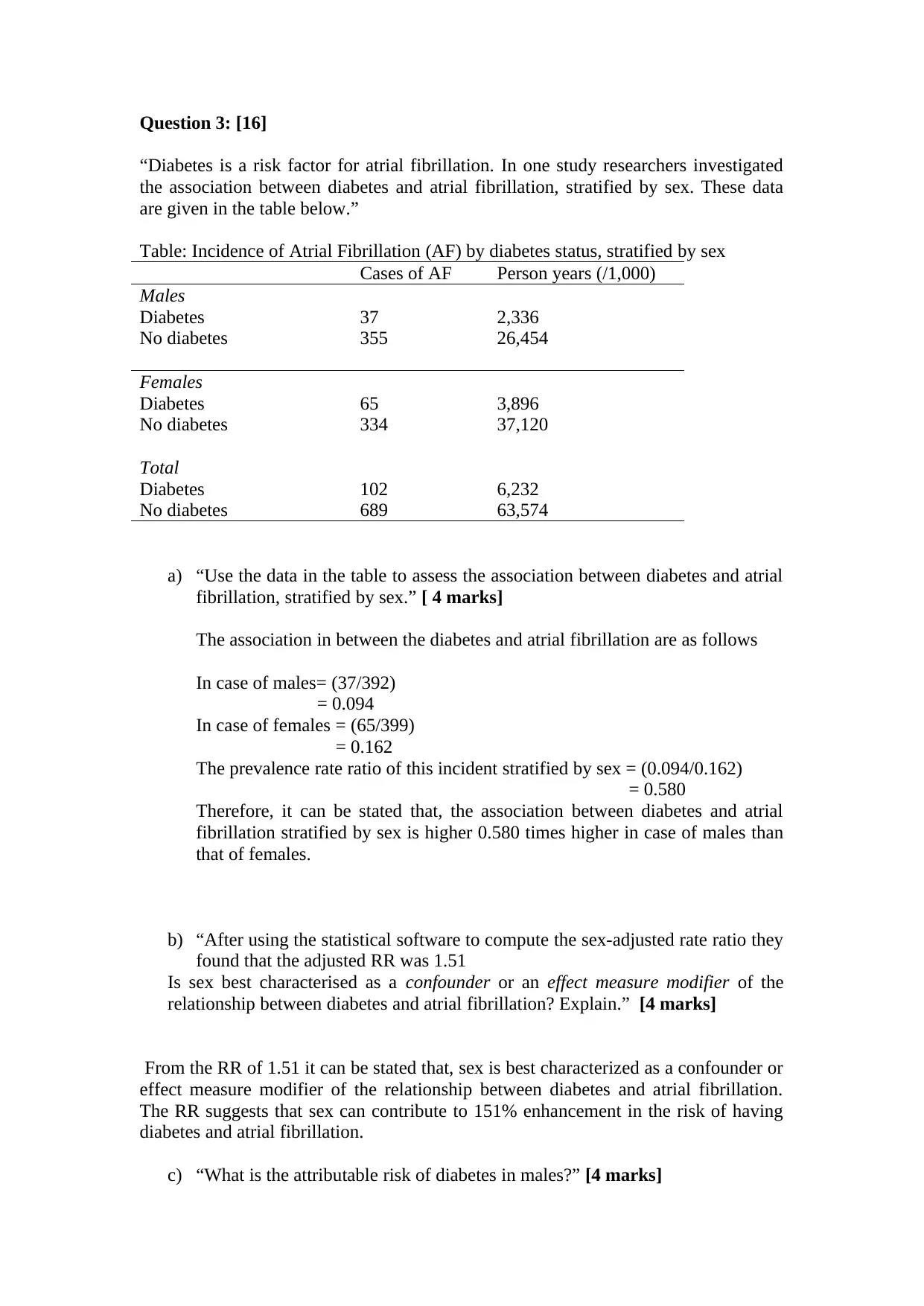
Question 3: [16]
“Diabetes is a risk factor for atrial fibrillation. In one study researchers investigated
the association between diabetes and atrial fibrillation, stratified by sex. These data
are given in the table below.”
Table: Incidence of Atrial Fibrillation (AF) by diabetes status, stratified by sex
Cases of AF Person years (/1,000)
Males
Diabetes 37 2,336
No diabetes 355 26,454
Females
Diabetes 65 3,896
No diabetes 334 37,120
Total
Diabetes 102 6,232
No diabetes 689 63,574
a) “Use the data in the table to assess the association between diabetes and atrial
fibrillation, stratified by sex.” [ 4 marks]
The association in between the diabetes and atrial fibrillation are as follows
In case of males= (37/392)
= 0.094
In case of females = (65/399)
= 0.162
The prevalence rate ratio of this incident stratified by sex = (0.094/0.162)
= 0.580
Therefore, it can be stated that, the association between diabetes and atrial
fibrillation stratified by sex is higher 0.580 times higher in case of males than
that of females.
b) “After using the statistical software to compute the sex-adjusted rate ratio they
found that the adjusted RR was 1.51
Is sex best characterised as a confounder or an effect measure modifier of the
relationship between diabetes and atrial fibrillation? Explain.” [4 marks]
From the RR of 1.51 it can be stated that, sex is best characterized as a confounder or
effect measure modifier of the relationship between diabetes and atrial fibrillation.
The RR suggests that sex can contribute to 151% enhancement in the risk of having
diabetes and atrial fibrillation.
c) “What is the attributable risk of diabetes in males?” [4 marks]
“Diabetes is a risk factor for atrial fibrillation. In one study researchers investigated
the association between diabetes and atrial fibrillation, stratified by sex. These data
are given in the table below.”
Table: Incidence of Atrial Fibrillation (AF) by diabetes status, stratified by sex
Cases of AF Person years (/1,000)
Males
Diabetes 37 2,336
No diabetes 355 26,454
Females
Diabetes 65 3,896
No diabetes 334 37,120
Total
Diabetes 102 6,232
No diabetes 689 63,574
a) “Use the data in the table to assess the association between diabetes and atrial
fibrillation, stratified by sex.” [ 4 marks]
The association in between the diabetes and atrial fibrillation are as follows
In case of males= (37/392)
= 0.094
In case of females = (65/399)
= 0.162
The prevalence rate ratio of this incident stratified by sex = (0.094/0.162)
= 0.580
Therefore, it can be stated that, the association between diabetes and atrial
fibrillation stratified by sex is higher 0.580 times higher in case of males than
that of females.
b) “After using the statistical software to compute the sex-adjusted rate ratio they
found that the adjusted RR was 1.51
Is sex best characterised as a confounder or an effect measure modifier of the
relationship between diabetes and atrial fibrillation? Explain.” [4 marks]
From the RR of 1.51 it can be stated that, sex is best characterized as a confounder or
effect measure modifier of the relationship between diabetes and atrial fibrillation.
The RR suggests that sex can contribute to 151% enhancement in the risk of having
diabetes and atrial fibrillation.
c) “What is the attributable risk of diabetes in males?” [4 marks]
⊘ This is a preview!⊘
Do you want full access?
Subscribe today to unlock all pages.

Trusted by 1+ million students worldwide
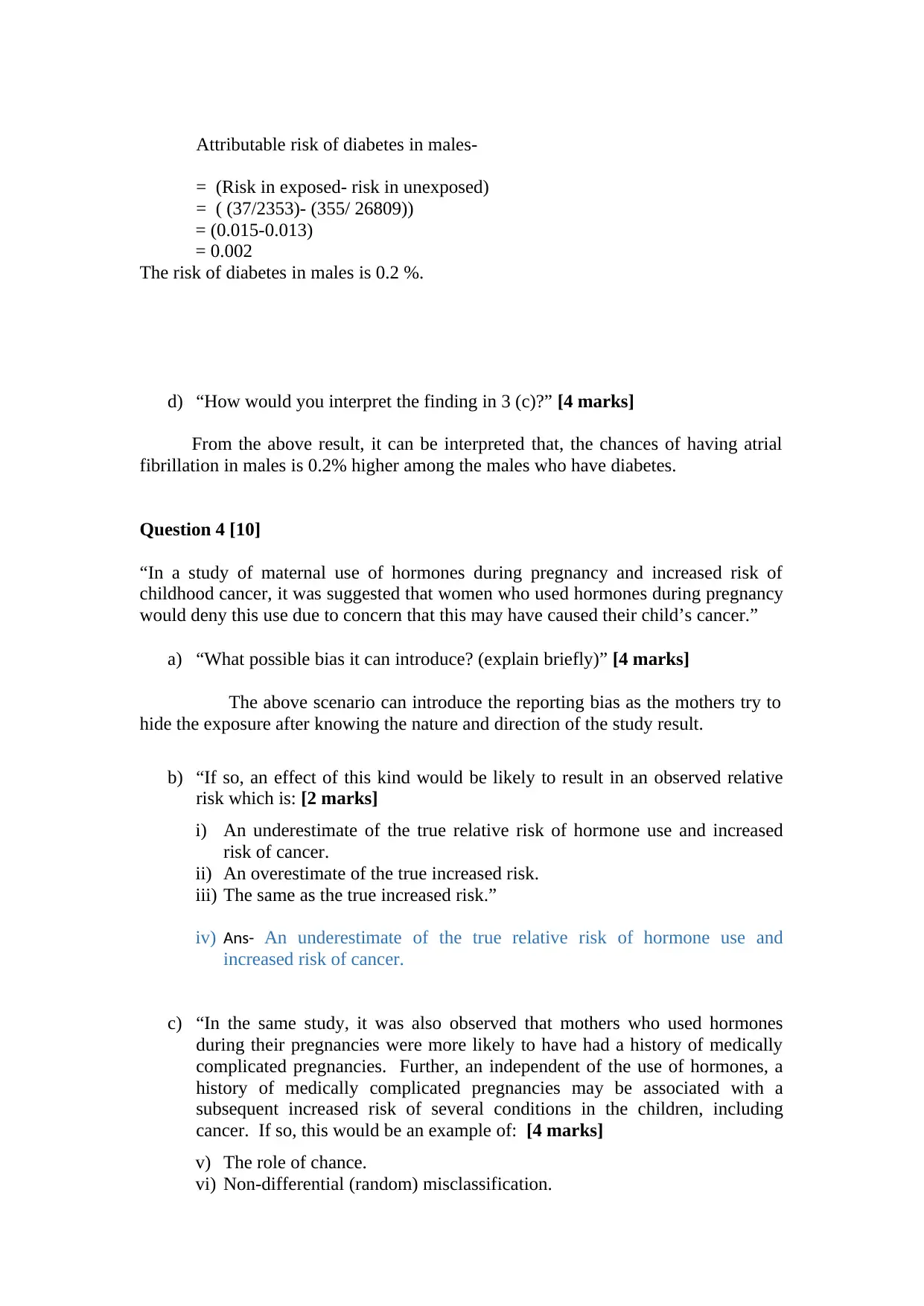
Attributable risk of diabetes in males-
= (Risk in exposed- risk in unexposed)
= ( (37/2353)- (355/ 26809))
= (0.015-0.013)
= 0.002
The risk of diabetes in males is 0.2 %.
d) “How would you interpret the finding in 3 (c)?” [4 marks]
From the above result, it can be interpreted that, the chances of having atrial
fibrillation in males is 0.2% higher among the males who have diabetes.
Question 4 [10]
“In a study of maternal use of hormones during pregnancy and increased risk of
childhood cancer, it was suggested that women who used hormones during pregnancy
would deny this use due to concern that this may have caused their child’s cancer.”
a) “What possible bias it can introduce? (explain briefly)” [4 marks]
The above scenario can introduce the reporting bias as the mothers try to
hide the exposure after knowing the nature and direction of the study result.
b) “If so, an effect of this kind would be likely to result in an observed relative
risk which is: [2 marks]
i) An underestimate of the true relative risk of hormone use and increased
risk of cancer.
ii) An overestimate of the true increased risk.
iii) The same as the true increased risk.”
iv) Ans- An underestimate of the true relative risk of hormone use and
increased risk of cancer.
c) “In the same study, it was also observed that mothers who used hormones
during their pregnancies were more likely to have had a history of medically
complicated pregnancies. Further, an independent of the use of hormones, a
history of medically complicated pregnancies may be associated with a
subsequent increased risk of several conditions in the children, including
cancer. If so, this would be an example of: [4 marks]
v) The role of chance.
vi) Non-differential (random) misclassification.
= (Risk in exposed- risk in unexposed)
= ( (37/2353)- (355/ 26809))
= (0.015-0.013)
= 0.002
The risk of diabetes in males is 0.2 %.
d) “How would you interpret the finding in 3 (c)?” [4 marks]
From the above result, it can be interpreted that, the chances of having atrial
fibrillation in males is 0.2% higher among the males who have diabetes.
Question 4 [10]
“In a study of maternal use of hormones during pregnancy and increased risk of
childhood cancer, it was suggested that women who used hormones during pregnancy
would deny this use due to concern that this may have caused their child’s cancer.”
a) “What possible bias it can introduce? (explain briefly)” [4 marks]
The above scenario can introduce the reporting bias as the mothers try to
hide the exposure after knowing the nature and direction of the study result.
b) “If so, an effect of this kind would be likely to result in an observed relative
risk which is: [2 marks]
i) An underestimate of the true relative risk of hormone use and increased
risk of cancer.
ii) An overestimate of the true increased risk.
iii) The same as the true increased risk.”
iv) Ans- An underestimate of the true relative risk of hormone use and
increased risk of cancer.
c) “In the same study, it was also observed that mothers who used hormones
during their pregnancies were more likely to have had a history of medically
complicated pregnancies. Further, an independent of the use of hormones, a
history of medically complicated pregnancies may be associated with a
subsequent increased risk of several conditions in the children, including
cancer. If so, this would be an example of: [4 marks]
v) The role of chance.
vi) Non-differential (random) misclassification.
Paraphrase This Document
Need a fresh take? Get an instant paraphrase of this document with our AI Paraphraser
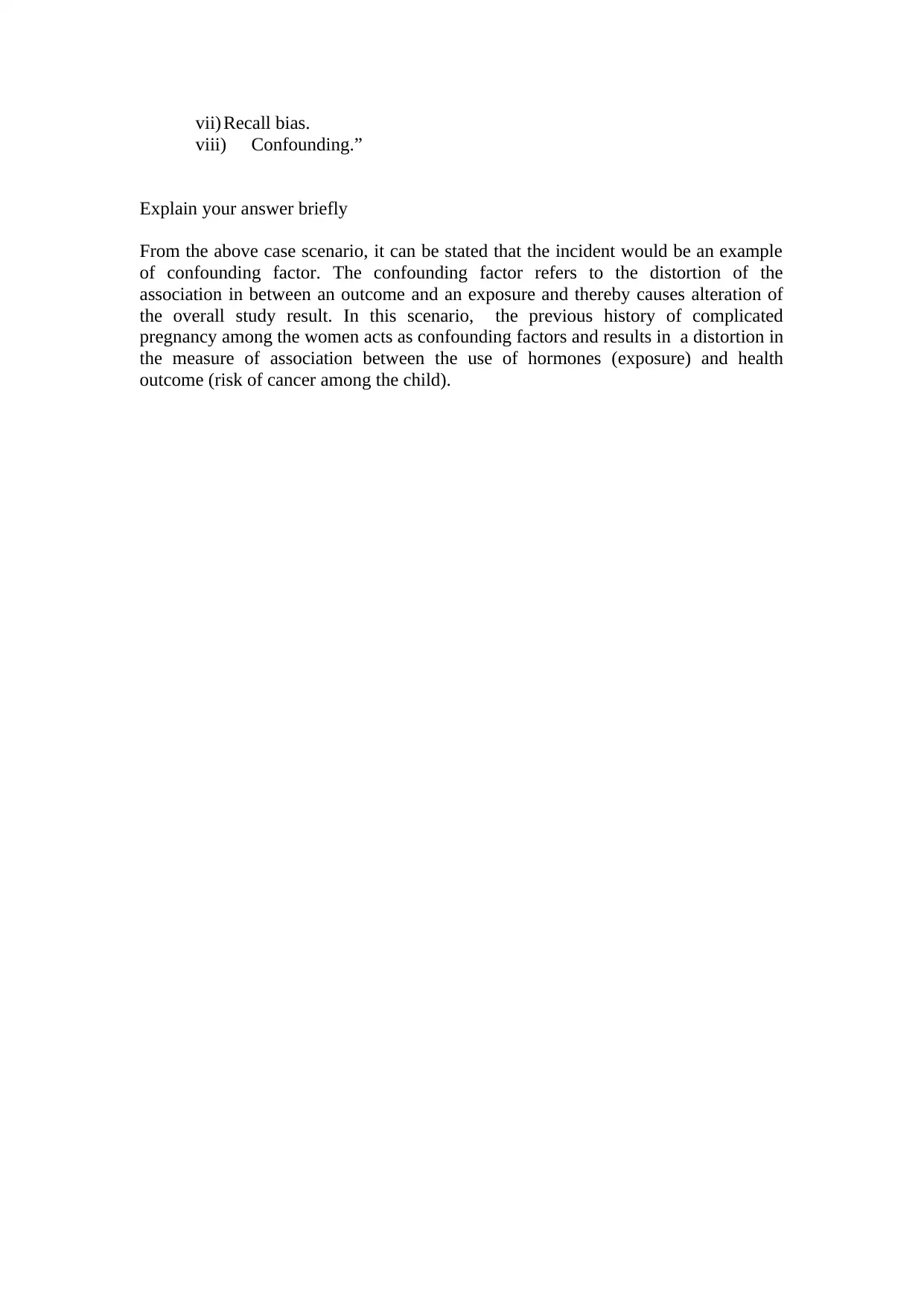
vii) Recall bias.
viii) Confounding.”
Explain your answer briefly
From the above case scenario, it can be stated that the incident would be an example
of confounding factor. The confounding factor refers to the distortion of the
association in between an outcome and an exposure and thereby causes alteration of
the overall study result. In this scenario, the previous history of complicated
pregnancy among the women acts as confounding factors and results in a distortion in
the measure of association between the use of hormones (exposure) and health
outcome (risk of cancer among the child).
viii) Confounding.”
Explain your answer briefly
From the above case scenario, it can be stated that the incident would be an example
of confounding factor. The confounding factor refers to the distortion of the
association in between an outcome and an exposure and thereby causes alteration of
the overall study result. In this scenario, the previous history of complicated
pregnancy among the women acts as confounding factors and results in a distortion in
the measure of association between the use of hormones (exposure) and health
outcome (risk of cancer among the child).
1 out of 8
Related Documents
Your All-in-One AI-Powered Toolkit for Academic Success.
+13062052269
info@desklib.com
Available 24*7 on WhatsApp / Email
![[object Object]](/_next/static/media/star-bottom.7253800d.svg)
Unlock your academic potential
Copyright © 2020–2025 A2Z Services. All Rights Reserved. Developed and managed by ZUCOL.



